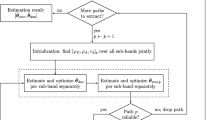Abstract
The RMS delay spread is often used to quantify the probability of inter-symbol interference in a propagation channel. A novel and straightforward procedure to assess this parameter is presented in this paper. A ray-tracing algorithm was used in an extensive set of Monte Carlo simulations to investigate the dependence of RMS delay spread on room parameters, namely its dimensions and average reflectivity. A multiple regression analysis was performed to obtain an empirical model for RMS delay spread assessment for indoor UWB propagation channels. The resulting model consists of a linear dependence of RMS delay spread on room dimensions combined with non-linear dependence on average reflectivity.





Similar content being viewed by others
References
Roy, S., et al. (2004). Ultrawideband radio design: The promise of high-speed, short-range wireless connectivity. Proceedings of IEEE, 92(2), 295–311.
Rappaport, T. S. (2001). Wireless communications: Principles and practice (2nd ed.). Upper Saddle River, NJ: Prentice Hall.
Shafi, M., Ogose, S., & Hattori, T. (2002). Wireless communications in the 21st century. New York: Wiley.
Lecointre, A., Dragomirescu, D., & Plana, R. (2009). Channel capacity limitations versus hardware implementation for UWB impulse radio communications. Romanian Journal of Information Science and Technology, 12(3), 339–353.
Kajiwara, A. (1997). Effects of polarization, antenna directivity, and room size on delay spread in LOS indoor radio channel. IEEE Transactions on Vehicular Technology, 46(1), 169–175.
McDonnel, J. T. E., Spiller, T. P., & Wilkinson, T. A. (1998). Characterization of the spatial distribution of RMS delay spread in indoor los wireless environments at 5.2 GHz. Proceedings of the 9th IEEE international symposium on personal. Indoor and Mobile Radio Communications, 2, 621–624.
Holloway, C. L., Cotton, M. G., & McKenna, P. (1999). A model for predicting the power delay profile characteristics inside a room. IEEE Transactions on Vehicular Technology, 48(4), 1110–1120.
Hansen, J., & Reitzner, M. (2004). Efficient indoor radio channel modeling based on integral geometry. IEEE Transactions on Antennas and Propagation, 52(9), 2456–2463.
Tait, G., Slocum, M., & Richardson, R. (2009). A model to predict reverberant decay time in reflective spaces for wireless applications. Proceedings of the 10th IEEE Annual Wireless and Microwave Technology Conference, 1, 1–5.
Coko, D., & Marinovic, I. (2014). Experimental verification of a deterministic UWB channel model for single room propagation scenarios. International Journal on Communications Antenna and Propagation, 4(2), 37–43.
Malik, W. Q., Edwards, D. J., & Stevens, C. J. (2007). Spatio-temporal ultrawideband indoor propagation modelling by reduced complexity geometric optics. IET Communications, 1(4), 751–759.
Zuo, X., & Wang, D. (2015). Characterization of indoor channels with directional antennas and performance evaluation. International Journal of Multimedia an d Ubiquitous Engineering, 10(8), 313–328.
Andersen, J. B., et al. (2007). Room electromagnetics. IEEE Antennas and Propagation Magazine, 49(2), 27–33.
Steinbock, G., et al. (2015). Experimental validation of the reverberation effect in room electromagnetics. IEEE Transactions on Antennas and Propagation, 63(5), 2041–2053.
Author information
Authors and Affiliations
Corresponding author
Rights and permissions
About this article
Cite this article
Coko, D., Marinovic, I. RMS Delay Spread Assessment for Indoor UWB Propagation Channels. Wireless Pers Commun 95, 2625–2633 (2017). https://doi.org/10.1007/s11277-017-3944-6
Published:
Issue Date:
DOI: https://doi.org/10.1007/s11277-017-3944-6




